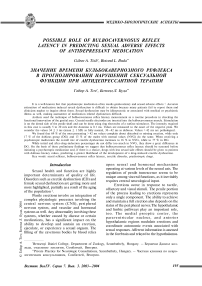Possible role of bulbocavernosus reflex latency in predicting sexual adverse effects of antidepressant medication
Автор: Toth Gabor A, Buda Botond L.
Журнал: Logos et Praxis @logos-et-praxis
Рубрика: Медико-биологические аспекты адаптации и социализации человека
Статья в выпуске: 3, 2003 года.
Бесплатный доступ
It is a well-known fact that psychotropic medication often results genitourinary and sexual adverse effects '. Accurate estimation of medication induced sexual dysfunction is difficult to obtain because many patients fail to report them and clinicians neglect to inquire about them. Sexual dysfunction may be idiosyncratic or associated with medical or psychiatric illness as well, making assessment of medication related dysfunction difficult. Authors used the technique of bulbocavernosus reflex latency measurement as a routine procedure in checking the functional innervation of the genital area. Coaxial needle electrodes are inserted into the bulbocavernosus muscle. Stimulation is on the dorsal side of the penile shaft and can be done using ring electrodes of a surface stimulator. The intensity required in this case is usually 5 to 20 mA and the duration is 0.1 ms. Values are measured to the onset of the negative peak. We consider the values 34 + 3 ms (mean + 1 SD) as fully normal, 38-42 ms as dubious. Values > 42 ms are pathological. We found that 69 % of the men presenting > 42 ms values complain about disturbed or missing erection, while only 17 % of the dubious group (DG) and 13 % of the males with normal values (NVG) do the same. When receiving a psychotropic medication the overall rate of erectile dysfunction increases to 16 % in NVG, while to 77 % in DG. While initial and after-drug-induction percentages do not differ too much in NVG, they show a great difference in DG. On the basis of these preliminary findings we suggest that bulbocavernosus reflex latency should be screened before initiating a psychotropic medication and, if there is a choice, drugs with less sexual side effects should be given to patients with dubious latency values, predicting a greater likelihood of the development of a drug-induced erectile dysfunction.
Sacral reflexes, bulbocavernosus reflex latency, erectile disorder, psychotropic drugs
Короткий адрес: https://sciup.org/14974909
IDR: 14974909
Список литературы Possible role of bulbocavernosus reflex latency in predicting sexual adverse effects of antidepressant medication
- Lundberg P.O., Biriell С. (1998) Sexual dysfunction as a suspected adverse reaction to antidepressant drags. Scan J Sex 1 (2): 97-105. 2 См.:
- Feldman H.A., Goldstein I., McKinlay J.В., Hatzichristou D.G., Krane R.J. (1994) Impotence and its medical and psychosocial correlates in men aged 40-70: results of the Massachusetts Male Aging Study. J Urol 151: 54-61;
- Johannes СВ., Araujo А.В., Feldman H.A., Derby C.A., Kleinman K.P., McKinlay J.B. (2000) Incidence of erectile dysfunction in men ages 40 to 69 years old: longitudinal results from the Massachusetts Male Aging Study. J Urol 163: 460-463.
- Rushworth G. (1967) Diagnostic value of the electromyographic study of reflex activity in man. Electroenceph Clin Neurophys S25: 65.
- Gutierrez M.A., Stimmel G.L. (1999) Management of and Counseling for Psychotropic Drag-Induced Sexual Dysfunction. Pharmacotherapy 19(7): 823-831; Pharmacotherapy Publications.
- Buda B.L. (1997) Bulbocavernosus Reflex Latency Checking in Predicting Drug-Induced Erectile Disorders. 13th International Congress of Sexology, Valencia, Spain. Abstract Book: 54.
- "Vodusek D.B., Fowler C.J. (1999) Clinical neurophysiology//Fowler C.J., editor. Neurology of bladder, bowel, and sexual dysfunction. Boston: Butterworth-Heinemann 109-143.
- Siroky M.B., Sax D.S., Krane R.J. (1979) Sacral signal tracing: The electrophysiology of the bulbocavernosus reflex. J Urol 122: 661-663.
- Dick H.C., Bradley W.E., Scott F.B., Timm G.W. (1974) Pudendal sexual reflexes. Electrophysiologic investigations. Urology 3: 376-379. 9 См.:
- Feldman H.A., Goldstein I., McKinlay J.B., Hatzichristou D.G., Krane R.J. (1994) Impotence and its medical and psychosocial correlates in men aged 40-70: results of the Massachusetts Male Aging Study. J Urol 151: 54-61.


